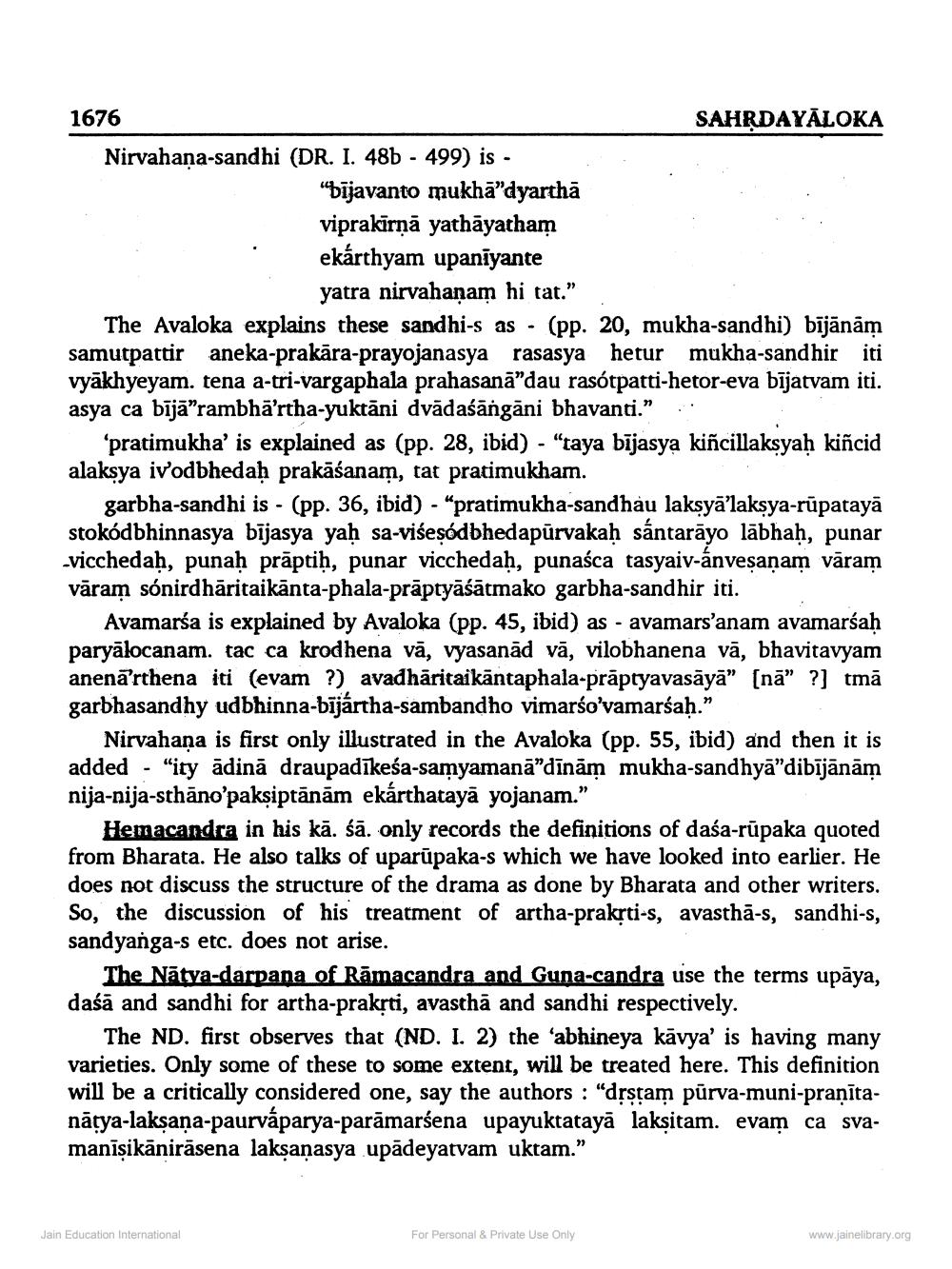________________
499) is -
.
1676
SAHRDAYĀLOKA Nirvahana-sandhi (DR. I. 48b - 499) is -
"bījavanto mukhā"dyarthā viprakīrṇā yathāyatham ekárthyam upanīyante
yatra nirvahaņam hi tat." The Avaloka explains these sandhi-s as - (pp. 20, mukha-sandhi) bījānām samutpattir aneka-prakāra-prayojanasya rasasya herur mukha-sandhir iti vyākhyeyam. tena a-tri-vargaphala prahasanā”dau rasótpatti-hetor-eva bījatvam iti. asya ca bījā”rambhā’rtha-yuktāni dvādaśāngāni bhavanti." :
'pratimukha' is explained as (pp. 28, ibid) - "taya bījasya kiñcillaksyaḥ kiñcid alaksya ivodbhedaḥ prakāśanam, tat pratimukham.
garbha-sandhi is - (pp. 36, ibid) - "pratimukha-sandhau laksyā’laksya-rūpatayā stokódbhinnasya bījasya yaḥ sa-viśesódbhedapūrvakaḥ sántarāyo lābhaḥ, punar -vicchedaḥ, punaḥ prāptiḥ, punar vicchedaḥ, punaśca tasyaiv-ánvesaņam vāram vāram sónirdhāritaikānta-phala-prāptyāśātmako garbha-sandhir iti.
Avamarśa is explained by Avaloka (pp. 45, ibid) as - avamars'anam avamarśaḥ paryālocanam. tac ca krodhena vā, vyasanad vā, vilobhanena vā, bhavitavyam anenā'rthena iti (evam ?) avadhāritaikāntaphala-prāptyavasāyā" (nā" ?] tmā garbhasandhy udbhinna-bījártha-sambandho vimarsovamarśaḥ.”
Nirvahana is first only illustrated in the Avaloka (pp. 55, ibid) and then it is added - "ity ādinā draupadīkeśa-samyamanā”dīnām mukha-sandhyā”dibījānām nija-nija-sthāno'pakṣiptānām ekárthatayā yojanam."
Hemacandra in his kā. śā. only records the definitions of daśa-rūpaka quoted from Bharata. He also talks of uparūpaka-s which we have looked into earlier. He does not discuss the structure of the drama as done by Bharata and other writers. So, the discussion of his treatment of artha-prakrti-s, avasthā-s, sandhi-s, sandyanga-s etc. does not arise.
The Nātya-darpana of Rāmacandra and Guna-candra use the terms upāya, daśā and sandhi for artha-praksti, avasthā and sandhi respectively.
The ND. first observes that (ND. I. 2) the ‘abhineya kāvya' is having many varieties. Only some of these to some extent, will be treated here. This definition will be a critically considered one, say the authors : "drstam pūrva-muni-pranītanātya-laksaņa-paurváparya-parāmarśena upayuktatayā lakṣitam. evam ca svamanīşikāniräsena laksanasya upādeyarvam ukram.”
Jain Education International
For Personal & Private Use Only
www.jainelibrary.org




